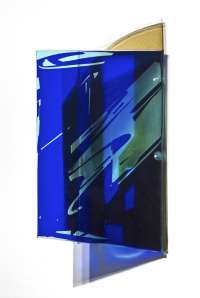Call for Unrealized Projects Olivia Booth September, 2012 oabooth@yahoo.com www.oliviabooth.net
GLASS DRUMMERS PAVILION This repositionable glass drummer's pavilion is meant to latch on to the ground level of any international style building with floor to ceiling glass windows or sliding doors; like a broach or a parasite, depending. Inside the 10 feet high, seven fee wide and four feet deep, colored slice of space is a drum-set to be played by any professional or amateur drummer, at any hour. The drummer would enter either from the inside, through the existing glass door of the host building, or from the outside, through a temporary tunnel. The pavilion’s slice of space– or as I see it a slash of space like the slash of a Lucio Fontana canvas– is meant to wrench space open, instigating rhythms tucked away in the present but unclear dimension of the glass plane. The pavilion stands as a counterpoint to the manner in which the glass plane is used in modern and contemporary urban architecture, where its glib overuse diminishes it to become just a kind of sign for openness and extension. The pavilion is also a shout-out to Paul Scheerbart’s vision for the future of colored glass, and a visual chance to wonder aloud about why he was right about glass taking over but not about colored glass doing so. The pavilion is also of course meant to play with one’s nerves, which is, after all, never a bad thing.
Call for Unrealized Projects Olivia Booth September, 2012 oabooth@yahoo.com www.oliviabooth.net
GLASS DRUMMERS PAVILION This repositionable glass drummer's pavilion is meant to latch on to the ground level of any international style building with floor to ceiling glass windows or sliding doors; like a broach or a parasite, depending. Inside the 10 feet high, seven fee wide and four feet deep, colored slice of space is a drum-set to be played by any professional or amateur drummer, at any hour. The drummer would enter either from the inside, through the existing glass door of the host building, or from the outside, through a temporary tunnel. The pavilion’s slice of space– or as I see it a slash of space like the slash of a Lucio Fontana canvas– is meant to wrench space open, instigating rhythms tucked away in the present but unclear dimension of the glass plane. The pavilion stands as a counterpoint to the manner in which the glass plane is used in modern and contemporary urban architecture, where its glib overuse diminishes it to become just a kind of sign for openness and extension. The pavilion is also a shout-out to Paul Scheerbart’s vision for the future of colored glass, and a visual chance to wonder aloud about why he was right about glass taking over but not about colored glass doing so. The pavilion is also of course meant to play with one’s nerves, which is, after all, never a bad thing.

